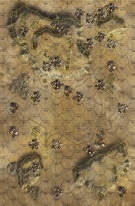| Author |
JayTownsend
|
| Method |
Solo |
| Victor |
Arab Republic of Egypt |
| Play Date |
2019-04-07 |
| Language |
English |
| Scenario |
SwIs019
|
1967: Sword of Israel, scenario #19: Breakout at Gifgafa
Back to 1967, which has a ton of scenarios I still want to play, I picked this one as it was quick play with only 12 turns, one map and a low unit count but an interesting mix of unit types and an interesting situation. There are four total victory levels which are kind of mixed conditions and can be kind of confusing when both sides obtain one type of victory. The Israelis try to stop the Egyptians from exiting units/steps off the west side of the map and eliminated enemy steps as well, while the Egyptians try to exit steps off the west edge and eliminate Israeli units on one the victory levels.
The Israeli AMX-13 & M51 tanks are weakly armored but have a nice punch in their AT fire-power and they have armor efficiency while the Egyptian T55s are a good fighting tank all the way around but have no efficiency. Both sides also have a lite mix of other units. Leaders are key, as they control all the units/counters on the map.
It turned into a 12 turn bloodbath with both sides taking many step losses. The Egyptians achieved a minor victory in two ways, by exiting more than 30 units off the west edge of the map, 31 actually and eliminating well over the eight steps, 27 total. The Israelis eliminated 32 Egyptian steps, way more than the requirement for either victory condition but lost way more than four steps and way more than eight steps, so achieved no victory condition and the Egyptian win a minor victory.
Scenario #19 special rule #3 uses a Vautour but I assumed when the M53 AA-Halftrack was present that it would increase the morale by one modifier if in range of the attacking Vautour. Since that wasn’t addressed in that one odd special rule, it was how I handled it.
It was fun to come back to this game, but I have to keep in mind, that are many subtle rule differences in Modern and Regular Panzer Grenadier, including stacking, Leaders, terrain and combat chart modifiers to name a few. Sometimes when I couldn’t remember something, I reverted back to PG rules.
|


 SwIs018
SwIs018 


























If we ever get 5 or six newcsmaller titles the differences between modern and ww2 era PG will become instinctual. Good concise summary.